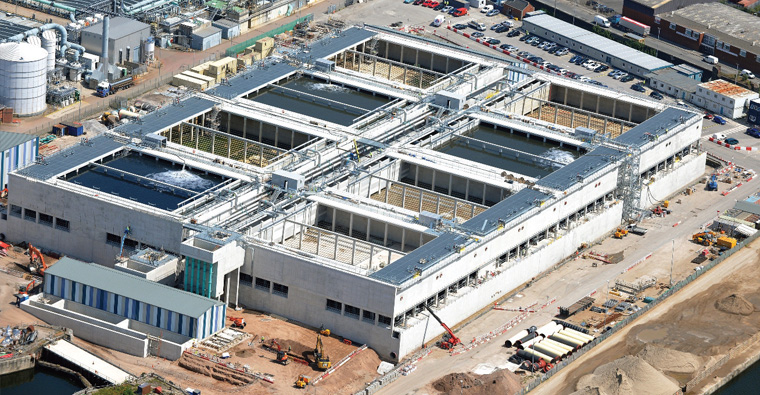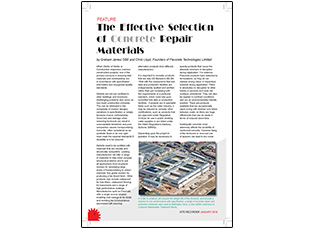In the January edition of Site Recorder, Chris Lloyd and Graham James look at some of the structural defects facing today’s building inspectors and explain the importance of selecting the right repair and protection solution.
When Clerks of Works or Construction Inspectors oversee construction projects, one of the primary concerns is ensuring that materials and workmanship are in accordance with specification information and recognised quality standards.
Defects are not just confined to older buildings and structures; challenging problems also occur on new build construction schemes. This can be attributed to the complexity of modern designs, variations to specification or simply because of poor workmanship. Grout loss and damage when removing formwork can result in unacceptable blemishes and poor compaction causes honeycombing. Concrete, often considered as an aesthetic finish in its own right, must meet the required standards if durability is to be assured.
Defects need to be rectified with materials that are visually and structurally compatible. Leading manufacturers will offer a range of materials to help solve complex structural problems and to suit all applications from structural mortars for reinstating large areas of honeycombing to colour matched, fine grade mortars for producing a fair-faced fi nish. Other products may include waterproof tie hole fillers, waterproof flooring for basements and a range of high performance coatings.
Single Source Repair Solution
Manufacturers such as Flexcrete offer a single source solution, enabling cost savings to be made and avoiding the inconvenience associated with sourcing alternative products from different manufacturers.
It is important to consider products that are fully CE Marked to BS EN 1504 with the reassurance that test data and production facilities are independently audited and verified rather than just complying with the requirements of a particular standard, which could rely upon unverified test data or production facilities. If projects are in specialist fields such as the water industry, it may be relevant to consider other certifications, such as products that are approved under Regulation 31(4)(a) for use in public drinking water supplies or are listed under the Water Regulations Advisory Scheme (WRAS).
Depending upon the project in question, it may be necessary to specify products that cause the absolute minimum of disruption during application. For instance, Flexcrete products have waterborne formulations, so they do not release strong odour or hazardous solvents during application. There is absolutely no disruption to other trades or services and work can continue unhindered. They can also be applied in confi ned conditions and are an environmentally friendly solution. There are products available that are exceptionally rapid curing with minimal cure times between coats, so there are huge efficiencies that can be made in terms of reduced down-time.
Inadequate concrete cover adversely affects the durability of reinforced concrete. Careless fixing of the formwork or incorrect use of spacers can lead to low cover. This undermines the protection of the steel reinforcement, ultimately leading to spalling and expensive maintenance. As soon as low concrete cover has been identified, it is important to take swift action, otherwise the lack of protection to the re-bars will lead to premature de-passivation of the steel and subsequent corrosion. Inadequate concrete cover will not only speed up the damaging effects of carbonation but also allow even more rapid ingress of chlorides, moisture and oxygen. At worst, sections of concrete may need to be demolished, or partial recasting may need to be carried out, however both these options are very costly and often difficult to carry out.
Advanced Cementitious Technology
In the last 30 years, major technical advances in cementitious coating technology have allowed extended service life solutions to be implemented. Cementitious coatings can be directly applied to reinforced concrete structures which are either approaching the end of their design life or which have suffered from premature degradation.
These high performance coatings can also be used on new build structures as part of the original design or to provide a solution to non-conformance with specification. Where critical structures such as bridges are being built in onerous marine environments, Consultants recognise the benefits of such coatings to help ensure the 120 year design life is achieved without the risk of costly future maintenance.
One product which is frequently specified on both existing and new structures to waterproof, reinstate cover and provide an effective barrier to chloride ingress is Cementitious Coating 851. 851 is a highly advanced, two component, waterborne cementitious modified polymer coating which was originally introduced in 1985, and it still remains one of the most effective products for providing structural protection against chloride attack. A 2mm coating of Cementitious Coating 851 is equivalent to 100mm of good quality concrete cover.
Independent tests have confirmed that Cementitious Coating 851 provides an effective barrier to chlorides for at least 28 years. In 1988, a 2mm thick film of Cementitious Coating 851 was applied to a concrete slice and sealed in a chloride ion diffusion cell and it is still going strong some 28 years (10,179 days) later. Ongoing tests carried out in the laboratory at the VINCI Technology Centre in Bedfordshire show that the barrier properties of 851 have not changed after a test period spanning the ongoing 28 years.
The performance of Cementitious Coating 851 in this test is unparalleled. Not only has the the product shown minimal permeability and constant yet very low diffusion coefficients, it has not shown any signs of deterioration despite being fully immersed in the chloride solution for over 28 years. From VINCI’s experience, many coating systems tend to degrade over time when on test in the cell. Even products that initially perform well can subsequently blister, resulting in more chloride ions passing through the product. Following the latest investigations and studies in concrete technology, VINCI’s internal testing can now determine a chloride ion diffusion coefficient from non-steady state conditions.
Based on the total chloride quantity which has been determined to diffuse through the 851 coating during 28 years on test, it has been calculated that this equates to a chloride ion diffusion coefficient of 8.53×10-13 cm2/s. By comparison for the uncoated reference concrete specimen, a chloride ion diffusion coefficient of 1.03×10-8 cm2/s was calculated based on the total chloride quantity that had diffused in the first 98 days on test when steady state was achieved. To put this in context, it would have taken 270 years for the product cell with the 851 to reach the same chloride concentration that the uncoated specimen reached in just 98 days.
Being cement based, Cementitious Coating 851 chemically reacts with the substrate to form an integral part and will have a design life equivalent to that of the concrete to which it is applied. 851 can be applied to either green or aged concrete by brush or spray techniques, exhibits minimal hazard during application and is non-toxic when cured. It is CE Marked in accordance with BS EN 1504-2, and has approval by the BBA, WRAS and the London Underground. In addition, it is approved under Regulation 31(4) (a) for use in contact with drinking water.
Find Out More About Flexcrete’s Concrete Repair & Protection Solutions
To download the article, please click on the button below:



